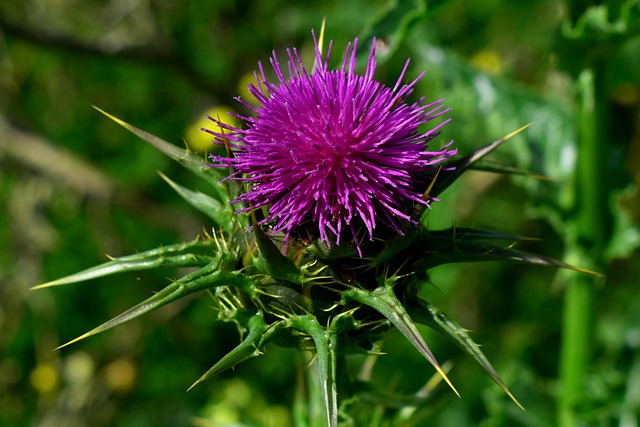 |  |  |   |  |
  |  |
Annual or biennial herb up to 150 cm tall. Strong stem, erect, little branched, hairy, bare or lightly covered with "spider" thread, formed 2 years. Rhizome leaves large, up to 80 cm long and 30 cm wide, elongated oval, strongly folded; the leaves of the stem are arranged alternately, leathery, shiny with a white pattern, yellow spines along the edge of the leaf and under the veins of the leaf. The flowers are crimson-violet or purple, collected in solitary ball-shaped inflorescences-baskets, which are protected by sharp inflorescence leaves. Flowers tubular, bisexual. Fruit - a white-spotted seed, wrinkled and up to 5 mm long. Blooms all summer. The fruits ripen in September-October.
Ripe dried fruits, as well as seeds and rhizomes are used for medicinal purposes. The seeds are collected in August-September, when the box dries. Harvest early in the morning before the flowers open, dry and store in breathable containers for 1 year. Roots are dug in autumn, washed, dried in the sun or in forced dryers at a temperature of 40-50C, stored in tightly sealed containers for no longer than 2 years.
The main active substances that are found in the fruits of the Milk Thistle are flavonoids and their derivatives (silybin, silicristin, silydianin, eriodictyol, etc.), vegetable fats (<32%), essential oil (0.08%), alkaloids, saponins, mucilages, organic substances, vitamin E, K, D, group B vitamins, biogenic amines (tyramine, histamine), macro and microelements, proteins, etc.
Medicinal significance
Preparations of the Milk Thistle strengthen the production and secretion of bile, strengthen the protective function of the liver against infections and various types of toxicosis. They produce antioxidant effects, stimulate the synthesis of structural proteins and phospholipids, stabilize liver cell membranes and accelerate their regeneration. The properties of the plant make it possible to use it to treat chronic hepatitis, cirrhosis, cholecystitis, as well as chemical poisoning, it will also be useful in the case of diabetes, chronic diseases of the digestive system, and varicose veins.
All parts of the plant can be used for medicinal purposes, but more often the fruits and seeds are used, from which oil and flour are obtained, as well as infusions and decoctions can be prepared. The fruits of the Milk Thistle are included in mixtures that treat diseases of the liver and spleen.
The preparations of the Milk Thistle also have a diuretic, temperature-reducing, carminative effect, as well as a normalizing action of the digestive tract. The Milk Thistle oil is also used externally as a wound healing agent. A decoction of the roots is used to rinse the teeth, in case of toothache, urinary retention, diarrhea and cramps.
In folk medicine, the juice of the Milk Thistle, squeezed from its leaves, is used as a mild laxative, sweat, urine and bile expelling agent. A decoction of the roots is used to treat gastritis, diarrhea, radiculitis, convulsions, and urinary retention. The pulp or flour of the Milk Thistle seeds helps reduce the sugar content in the blood, cleans the blood and helps with varicose veins.
